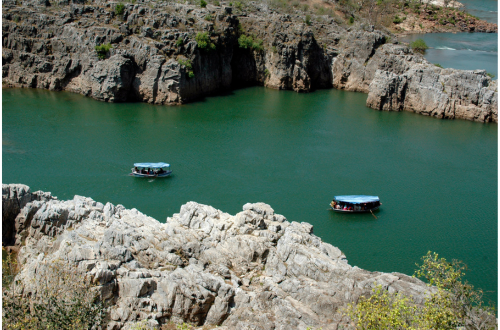Table of Contents
- Introduction
- 1. Narmada in the Ramayana
- 2. Narmada in the Mahabharata
- 3. Sacred Geography in Epics
- 4. Symbolism in the Epics
- 5. Living Traditions
- Conclusion
Introduction
The sacred Narmada River is deeply woven into India’s cultural and spiritual fabric. Beyond geography, she appears in the great epics — the Ramayana and the Mahabharata — as a divine presence and a witness to legendary events. These references highlight the river’s importance not only as a life-giving force but also as a bridge between mythology, faith, and history.
1. Narmada in the Ramayana
- During their exile, Lord Rama, Sita, and Lakshmana are believed to have visited Amarkantak, the origin of the Narmada.
- The river’s pure waters are said to have refreshed them during their journey through the forests of central India.
- Local traditions preserve stories of shrines and ghats linked to Rama’s presence on the riverbanks.
2. Narmada in the Mahabharata
- The Mahabharata describes the Pandavas wandering through the Narmada valley during their exile.
- Bhima is believed to have performed penance on her banks for strength.
- Legends also suggest that Arjuna sought blessings along the river before receiving divine weapons.
3. Sacred Geography in Epics
- Omkareshwar: Associated with Shiva worship, it is believed the Pandavas visited here.
- Maheshwar: Local lore connects its ghats to episodes from the epics.
- Amarkantak: Revered as the fountainhead of the Narmada, sanctified by references in epic traditions.
4. Symbolism in the Epics
- In both the Ramayana and Mahabharata, the Narmada is more than a river—she symbolizes purity, endurance, and liberation.
- The epics reinforce the belief that even remembering or seeing the river grants spiritual merit.
- The Narmada embodies the eternal flow of dharma (righteousness) through time.
5. Living Traditions
- Folk songs and oral storytelling in villages along the Narmada still celebrate these epic connections.
- Annual fairs and pilgrimages at Amarkantak and Omkareshwar often invoke stories from the epics.
- Pilgrims believe that by visiting these places, they walk in the footsteps of gods and heroes.
Conclusion
The Narmada’s presence in the Ramayana and the Mahabharata elevates her from a natural wonder to a timeless river of dharma. Flowing through India’s heartland, she carries the memory of Rama’s exile, the Pandavas’ struggles, and the eternal quest for divine blessings. To journey along her waters is to walk beside the heroes and sages of ancient epics, experiencing mythology in the living landscape.
